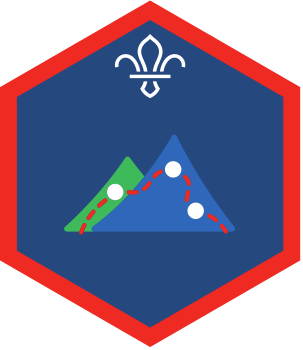Compass drawings
You’ll need
- Pens or pencils
- Erasers
- Scrap paper
- OS or other map printout of the local area, one per group
- Waterproof map case, as needed
- Compasses
- Mobile phone with a route tracking app, one per group
- Suitable hiking gear for everyone
Before you begin
- This activity requires advanced compass skills and the ability to use bearings. Consider running Navigation stations beforehand to brush up on these.
- Have a look through this advice on running hillwalking activities. Ideally, this activity should be run around the local area, to help with accessibility, familiarity and travel time for your helpers. You’ll probably need to run this activity across two sessions, with one spent planning the routes and one spent walking them.
- Make sure you have enough helpers and leaders available to supervise your group on a hike around the local area and help with navigation techniques. Each one will need to bring a mobile phone with a route-tracking app downloaded. This needs to be enabled during the hike to trace the route taken. If this isn’t possible, try to use a young person’s phone or have a leader trace the route taken in pencil on the map printout.
- Set out tables and chairs for each group. Put a map, pens, pencils and paper on each table.
Plan the route
- Split everyone into equal groups. Each group should sit together at a table.
- Explain that each group should create a route on their map for another group to walk. This route should include the use of bearings, deviations and triangulation where necessary. Explain that each group will be accompanied by a helper carrying a route-tracking app that will trace the route taken from start to finish, making a shape on the map.
- Groups should start by drawing their shape in pencil on the map, connecting it up to the start and finish point, which should be the same. They can use this to come up with instructions for the other group to follow based on where the lines lead.
- Give each group a number and have them write it on the top of their instructions. When all of the instructions have been finished, the person leading the activity should make a note of who’s in each group and which helper will be accompanying them.
Compass drawings
- Separate the groups. Make sure they’ve got everything they need, are suitably dressed and have filled their water bottles. Give everyone a set of instructions created by another group.
- When everyone sets off from their start point, their helper should start the route-tracking app to record the route taken. When each group finishes their route, their helper should stop the route-tracking app to reveal the picture.
- Gather everyone back together and compare pictures to see who how well everyone did.
Reflection
Going out and practising skills you’ve learnt fixes them in your mind and helps you remember them when you next need them. What did you find most challenging about this activity? Think about how you used new skills, the terrain and area you walked in, the weather, and whether you were properly prepared for everything. Is there anything you would’ve done differently, if you were to do this activity again?
Being active and going on a hike also helps you feel better about yourself and appreciate the outdoors. Having the opportunity to walk in nature lets you see the world we live in and appreciate how important the environment is. How might following a set route on public footpaths and roads be better for the environment than taking shortcuts across natural spaces?
Safety
All activities must be safely managed. You must complete a thorough risk assessment and take appropriate steps to reduce risk. Use the safety checklist to help you plan and risk assess your activity. Always get approval for the activity, and have suitable supervision and an InTouch process.
- Outdoor activities
You must have permission to use the location. Always check the weather forecast, and inform parents and carers of any change in venue.
- Hiking and walking
Follow the guidance for activities in Terrain Zero, or the guidance for each the adventurous activity.
- Dark
Provide some light, so the environment isn’t completely dark. Everyone must be able to see others and move around the area safely.
- Phones and cameras
Make sure parents and carers are aware and have given consent for photography.
You could complete this challenge in an unfamiliar location, perhaps on a night away, for more of a challenge.
- Check all the routes planned by the groups to see whether they’re all accessible for everybody.
- Anyone who doesn’t wish to complete a hike could demonstrate the skills in a different way. For instance, their group could walk the route without instructions and that person could remain at the start point and relay the instructions and navigation techniques required.
All Scout activities should be inclusive and accessible.
With appropriate supervision, the group could run a shorter, simplified version of this activity for a younger group.
The group designed and walked the hikes in this activity, demonstrating navigational skills in the process


